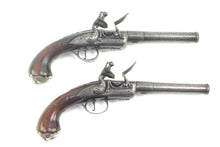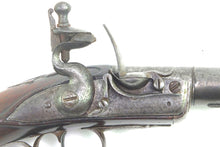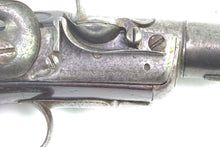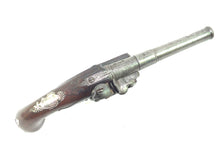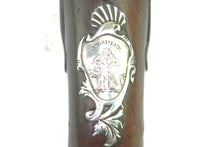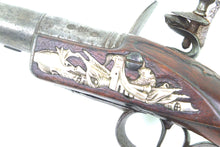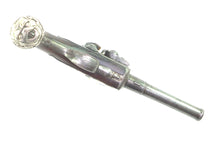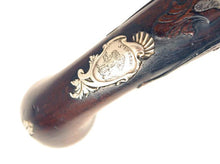
A Historic Pair of Flintlock Queen Anne Pistols by Griffin of Bond Street. 12” overall, 5”round 20 bore turn off barrels swelling at the muzzles, barrels numbered 1 and 2, engraved ‘LONDON’ & stamped with London proofs and Foreigners mark on top of the breach, foliate engraved tangs cut with sighting grooves, signed ‘Griffin Bond Street’, border engraved locks with cocks decorated en suite. Half stocked in walnut cut with raised aprons behind the tangs and around the locks, silver mounts comprising grotesque masks stamped with hallmarks, pierced side plates, Rococo escutcheons engraved with the original owner’s crest of a boar beneath a tree and motto ‘J ESPERE’ for the Swinton Family, steel trigger guards engraved with an oval on the bow.
Circa 1750.
In good condition, one pistol with burn marks beneath the trigger guard.
Provenance:
Kimmerghame, Duns, the Estate of the Late Major General Sir John Swinton K.C.V.O., O.B.E., D.L.
Captain Archibald Swinton (1731-1804) was a Scottish surgeon who went to India in the service of the East India Company. He reached Madras in 1752 and took part in the campaigns being waged between the French and English Companies for supremacy in the south. He also took part in an expedition 1756-57 to Negrais in Burma, arriving at Ganjam in Eastern India in 1759 and from there went on to Calcutta. During this time he also transferred from being a surgeon to an ensignship in the Company’s Bengal army. When Archibald Swinton left the Company’s service at the end of 1765, he also left India with an unprecedented mastery of the Persian language, local customs and strong relationships with the Mughal nobility. Swinton was a very early collector of Indian and Mughal art and on returning to Scotland he brought with him a substantial collection Indian paintings, works of art, ivories, arms, jewels, Persian books and silver and jade handled daggers. This is documented in family papers. The significance of Swinton’s pioneering interest in Indian culture and early patronage of Indian art was recently recognised by the acceptance of an important group of Indian paintings, weapons and other works of art by the nation in lieu of inheritance tax, allocated to the National Museum of Scotland in 2021.
These pistols are dated to the same period that Swinton was serving in India and it is highly likely that they accompanied him on his journey as they bear his crest and motto.
Benjamin Griffin. Apprenticed to Samuel Harrison, 1719; gave up apprentice and worked as Foreign gunmaker allowed to prove guns by Gunmakers Co., 1724-31. Told to give up work by Gunmakers CO., but traded as gunmaker (Successor to Samuel Garrison), Bond St., 1735-70. Registered silversmiths mark, Goldsmiths Hall, 1743. With son, Joseph, took out Sun Ins. (No. 159594)on goods at Cross & Griffin, New Bond Street., 1757. Died 1770.
Joseph Son of Benjamin. Apprenticed to Samuel Blanckley, turned over to father, 1741; free of Gunmakers CO., 1750. Proof piece and mark 1759. Elected Assistant, 1759; Master, 1762, 1763. Appointed Gentlemen Armourer to His Majestys Stables-in-Ordinary, 1760. Gunmaker to His Majesty near the Duke of Graftons, Bond Street., 1763. In partnership with father until 1770, then with John Tow, 1772-82. Died in 1784. Succeeded by John Tow.













